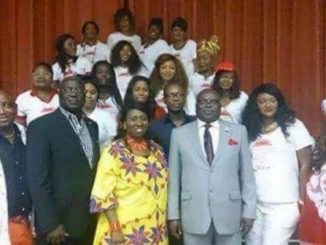
Dummies: Proportional Representation – Much Ado About Political Nothingness for Salone
By N’fa Alie (19/07/2022)
The hullabaloo about the Proportional Representation PR system is much ado about political nothingness, Sierra Leone style. More details follow.


As a representative form of government, PR, contrary to widely held WhatsApp notions, is actually a fairly common electoral system in the international arena. Many nations around the world have adopted various forms of PR as a means of producing legislatures that more accurately reflect the views and aspirations of the people. Of a total of 195 formally-recognized countries in the world, 94 practice PR. When one considers the fact that out of the remaining 101 countries that practice different iterations of first-past-the-post models, 57 are full-blown autocracies, PR is by a mile the most popular electoral system in the world. (Photo: Failed President Bio is misusing the unpatriotic MPs to cheat his way to victory come 2023 elections).
From Africa to Asia, to Europe to North America countries large and small, rich or poor, full-fledged as well as semi-democracies have all experimented with the PR system. For example, the German Bundestag, the lower house of parliament, uses proportional representation to elect its members. All of the Scandinavian and Baltic countries, namely Norway, Sweden, Denmark, Finland, Estonia, Latvia, and Lithuania, countries that consistently score the highest in the annual democracy and good governance index, are huge proponents and practitioners of PR. In what is known as the Nordic Model, adherents such as Ernest Naville argue quite vociferously that while in a democratic government, the right of decision belongs to the majority, in a representative democracy the right of representation belongs to ALL.
Why PR Matters
The single-member district voting system has been on the wane worldwide because it has a number of glaring shortcomings. It routinely denies representation to large numbers of voters, produces legislatures that fail to accurately reflect the views of the public, discriminates against third parties, and discourages voter turnout. PR on the other hand is gaining traction largely because it avoids an outcome in which some people win representation and the rest are left out. Under PR rules, no significant groups are denied representation. Even political minorities, who may constitute only 10-20 percent of the voters, are able to win some seats in multi-member districts. To put it another way, In classic PR systems, nearly everyone’s vote counts, with 80-90 percent of the voters actually electing someone. (Parliament under siege).

At its core, the PR system aims to create a representative body that better reflects ALL of the citizens’ interests in an electorate or voting district. In an election, political parties that earn votes win a number of seats in the representative body that are directly proportional to the number of votes they received in the election. For example, if a party earned 40% of the vote in an election, they would receive 40% of the seats in the House of Representatives. In its purest form, equal representation is considered a fundamental human right, one equated with fairness, equity, and Justice.
Types
There are four main types of PR systems: Closed Party List system; Open Party List system; Single Transferable Vote (STV) system; and the Mixed Member Proportional (MMP). The first two are party-centric, STV is candidate-centric and the MMP is both party and candidate-centric.
- In a Closed Party List system, the elector votes for a party’s list of candidates instead of a single candidate. Each party then receives a share of the seats proportional to the share of votes it received. The party predetermines the list order who will be assigned seats, not the voters.
- In an Open Party List system, the elector votes for individual candidates on a party’s list of candidates instead of its predetermined order. Each party then receives a share of the seats proportional to the share of votes their candidates received. Voters determine the list order of candidates receiving seats, not the party. In Sweden’s Riksdag elections, for example, 310 members are elected using “Open Party List” PR in 29 districts. About 25% of voters choose to just vote for a party, which orders its own list. The remaining 39 adjustment seats are distributed amongst the 8 parties which met the 4% threshold, to match Riksdag seat assignments to the percentage of votes received nationally, as closely as possible.
- In a Single Transferable Vote (STV) system voters rank their choice of candidates on the ballot instead of voting for just one candidate. Mixed Member Proportional (MMP) with an Open List system (mixed party and candidate), each elector casts two votes instead of one. On a double ballot, the elector chooses a party of choice and also his or her favorite candidate among those listed. It’s also called an Open Party List system. Each of the 94 countries that use PR has its own formula for arriving at proportionality. Most use some combination of these four variations.
Several Advantages Account for its Popularity
- Well-designed and implemented PR systems can accurately represent 95% to 99% of the electorate. Votes cast accurately and effectively translate into seats won.
- PR encourages or requires the formation of political parties or groups of like-minded candidates, to put forward lists.
- PR can produce very few wasted votes. When thresholds are low, almost all votes cast in Pro Rep elections elect a candidate of choice, faithfully preserving voter intent.
- PR facilitates minority parties’ access to representation.
- It encourages parties to campaign beyond the districts in which they are strong or where the results are expected to be close. This restricts the growth of ‘regional fiefdoms’.
- Leads to greater continuity and stability of policy. Policies tend not to lurch from left to right to left again.
- Makes power-sharing between parties and interest groups more visible.
- It is also gender-friendly. All countries in Western Europe where the number of women in Parliament exceeds 20% have adopted the proportional system
Conclusion
It is by no means perfect. It can be confusing and time-consuming. Its advantages however outweigh its shortfalls. In conclusion, it is no exaggeration to state that PR is the best mechanism for fostering free, fair, and transparent competition among all political parties in a fledgling democracy. It is the best antidote for energizing the electoral process and ensure a fair, just and equitable representation across the board. Courtesy: N’fa Alie © July 2022
FROM THE ORGANIZER NEWSPAPER



